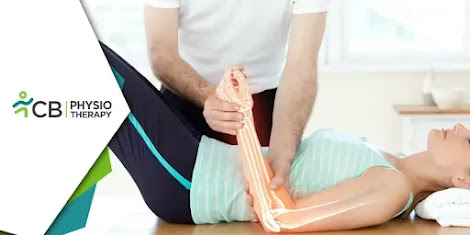Knee osteoarthritis (OA) is a prevalent degenerative joint disease characterised by the breakdown of cartilage, leading to pain, stiffness, and impaired movement. As the condition progresses, the bones within the knee joint may begin to rub against each other, causing significant discomfort and reducing the quality of life. Treatment options vary from lifestyle modifications and medications to surgical interventions, but non-surgical approaches like physiotherapy are often sought to manage symptoms and delay the need for surgery.
Manual Traction: An Overview
Manual traction, a physiotherapy technique, involves the application of a gentle, pulling force to a joint to stretch the surrounding tissues, increase space within the joint, and potentially reduce pain. In the context of knee osteoarthritis, manual traction aims to alleviate pressure on the joint surfaces, improve mobility, and enhance the overall function of the knee.
The effectiveness of manual traction for knee osteoarthritis is an area of growing interest within the field of physical therapy. Several studies have explored its potential benefits, with findings indicating positive outcomes for many patients. Key benefits observed include:
1: Pain Reduction: By reducing joint compression, manual traction can help alleviate pain associated with knee osteoarthritis. This is particularly beneficial for patients experiencing severe discomfort due to bone-on-bone contact within the joint.
2: Improved Mobility: Manual traction can enhance the range of motion by stretching the joint capsule and surrounding soft tissues. This can lead to improved function and greater ease in performing daily activities.
3: Decreased Stiffness: Regular application of manual traction may reduce stiffness in the knee joint, making movement less painful and more fluid.
4: Enhanced Joint Nutrition: The process of traction can promote synovial fluid movement within the joint, which is essential for nourishing the cartilage and maintaining joint health.
Techniques of Manual Traction
Manual traction can be performed using various techniques, each tailored to the patient’s specific needs and the severity of their osteoarthritis. Here are some commonly used methods:
1. Longitudinal Traction
a) Description: Longitudinal traction involves applying a pulling force along the axis of the leg to separate the joint surfaces.
b) Technique:
The patient lies on their back with the knee slightly bent.
The therapist gently grasps the lower leg near the ankle.
A steady, gentle pull is applied, creating a distraction force that separates the knee joint surfaces.
c) Benefits:
Reduces joint compression.
Alleviates pain by minimising bone-on-bone contact.
Can be adjusted in intensity to suit patient comfort.
2. Positional Traction
a) Description: Positional traction utilizes the positioning of the patient’s body to create a traction force on the knee joint.
b) Technique:
The patient is positioned in a way that gravity assists in creating a distraction force.
Common positions include lying on the side with the affected knee over the edge of the table, allowing gravity to pull the leg downward.
c) Benefits:
Requires minimal manual effort from the therapist.
Can be easily performed at home with proper guidance.
3. Manual Glides and Joint Mobilizations
a) Description: This technique combines manual traction with joint mobilization, involving oscillatory movements to improve joint mechanics.
b) Technique:
The patient lies comfortably, often on their back.
The therapist applies a sustained traction force while simultaneously performing gentle gliding motions of the joint surfaces.
Movements can be in different directions (anterior-posterior, medial-lateral) to target specific areas of stiffness.
c) Benefits:
Enhances joint mobility by addressing specific restrictions.
Can be highly customized to the patient’s needs.
4. Assisted Devices and Techniques
a) Description: Various devices, such as traction tables or straps, can assist in providing consistent and controlled traction forces.
b) Technique:
Traction tables allow for precise control over the traction force and duration.
Straps and belts can be used to secure the patient’s leg and apply traction manually or mechanically.
c) Benefits:
Provides consistent and measurable traction forces.
Can be particularly useful for severe cases where manual traction alone is insufficient.
Combining Manual Traction with Other Therapies While manual traction can be effective on its own, combining it with other therapeutic modalities often yields better results. Some complementary therapies include:
1. Exercise Therapy
Regular, targeted exercises can strengthen the muscles around the knee, improve joint stability, and enhance overall function. Combining manual traction with exercises such as quadriceps strengthening, hamstring stretches, and low-impact aerobic activities like swimming or cycling can optimize outcomes.
2. Thermal Therapies
Applying heat or cold to the knee joint before or after traction sessions can help manage pain and inflammation. Heat therapy increases blood flow and relaxes muscles, while cold therapy reduces swelling and numbs pain.
3. Manual Therapy Techniques
Incorporating other manual therapy techniques, such as soft tissue massage or myofascial release, can address muscle tightness and improve overall joint mechanics.
Patient Considerations and Safety When applying manual traction, it’s essential to consider the patient’s overall health, the severity of their osteoarthritis, and any contraindications. Factors such as osteoporosis, severe joint instability, or acute inflammation may necessitate modifications or alternative treatments. It’s also crucial to ensure that the traction force is gentle and within the patient’s comfort range to prevent exacerbation of symptoms.
Manual traction represents a valuable non-surgical intervention for managing knee osteoarthritis. Its ability to reduce pain, improve mobility, and enhance joint health makes it a promising option for many patients. By understanding the various techniques and combining them with other therapeutic approaches, physiotherapists can tailored treatments to individual needs, ultimately improving outcomes and quality of life for those affected by knee osteoarthritis. As with any therapy, ongoing research and clinical experience will continue to refine and validate the best practices for using manual traction in this context.





